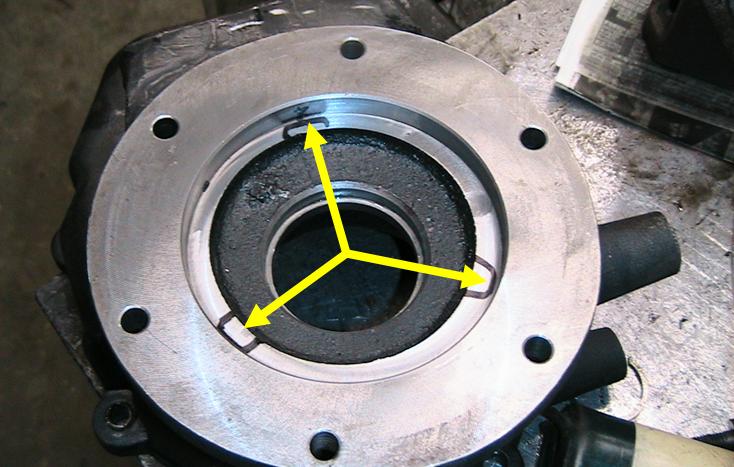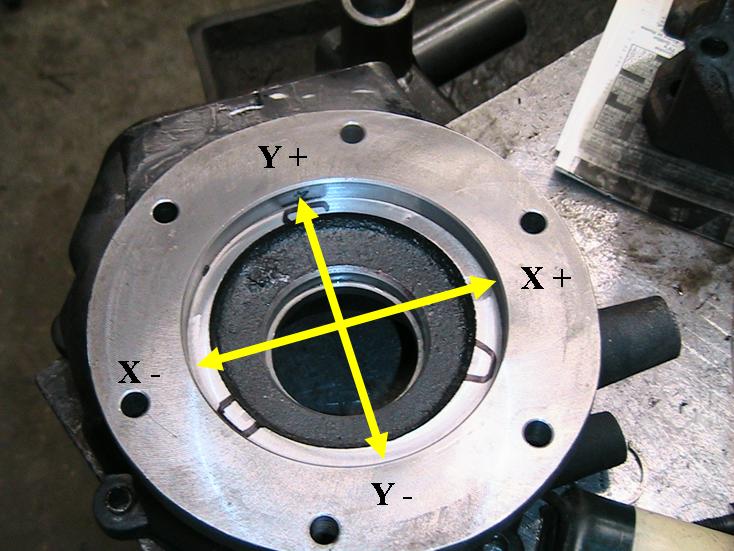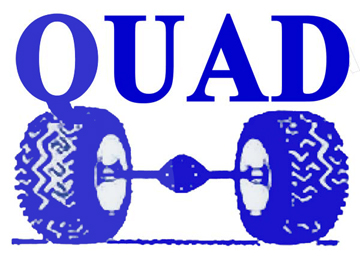|
|
|
|
|
Documenting Defects in
Imported NV4500 Cast Iron Tailshaft Housings
By Dan Guarino
It all started with a phone call from a
customer who was stranded 400 miles from home with a blown 5th
gear in an NV4500 transmission we had sent him about 6 months
back. From his description of what happened, I knew it had
to be either a countershaft clutch failure or fifth gear tooth
breakage. The customer
also mentioned the transmission had been unduly noisy since day
one. Now some gear noise especially in 5th gear at low
rpm's is not unusual with NV4500 transmissions, but the customer
stated this transmission was definitely a bit on the loud side.
Well, when you
are in the business of fixing things and selling parts, you know
sooner or later something is going to come back at you.
Still, out of all the hundreds of NV4500 transmissions we had
worked on or sold since our first one 1996, our NV4500 comebacks
totaled one brand new transmission in 1997 with a cracked case,
and 5 rebuilt transmissions in 2001 that had to have the reverse
shift fork pads replaced when a supplier had sneaked some
counterfeit pads into an order of genuine New Venture parts.
About 4 days
later the transmission showed up at our door. From the
moment I got my hands on it and turned the shafts, I knew we had
a case of 5th gear tooth breakage, but why? Actual gear
breakage in NV4500 transmissions is rare and fifth gear tooth
breakage is almost unheard of.
A few weeks prior to this incident, we had learned our supplier
of these cast iron bellhousings knew of an interference problem
with certain NV241 transfer cases but was not telling anyone
about it.. We had one of those problems with a 1996 Dodge
so I called them up and spoke to our about-to-retire salesman.
He told me they knew of some problems but not many. OK
that gave us a clue, so before pulling the tailshaft housing, we
looked for evidence the transfer case bearing retainer was
hitting the tailshaft housing, and sure enough, three marks were
visible back of the cast iron housing. These dents were
caused by the transfer case bearing retainer bottoming out
against the tailshaft housing. We then pulled the
tailshaft housing and looked at what was left of the fifth
gears. Yep you guessed it, an uneven wear pattern was
present confirming the failure was a case of mis-alginment.
We checked the tooth angle on the gears, it was perfect.
Next, we checked the gear bores and shafts for trueness, again
right on the money. So, at that point, the cast iron
tailshaft housing was suspect #1. |
 |
Areas where NV241 Transfer Case Bearing
Retainers hit imported cast iron tailshaft housings before
transfer case mating flange is tight against cast iron output
housing. This problem seems to occur primarily on 1997 and older
Dodge 2500 and 3500 trucks with the wide input bearing. This can
cause the transfer case to be cocked or mis-aligned
Excessive gear noise, bearing failures, transfer case breakage,
transmission gear failure, and propeller shaft vibrations are
all possible. This interference problem can be corrected by
modifying either or both the tailshaft housing and transfer case
bearing retainer. |
|
Believing we had found the cause of the
failure, we bored out the tailshaft housing to provide
clearance. To be on the safe side, we also decided to
check the bores on the cast iron housing. We
couldn't believe the results so we checked 3 more cast iron
housings and 3 original equipment housings. To verify the
results we had a machine shop perform the same tests. What
follows is from the documentation we sent the supplier:
To check the
run-out:
1. Brand
new NV4500 transmission case were securely mounted on a vertical
mill with the rear output bearing bore up (two cases were used,
results the same on either case). A indicator reading was taken
off the rear face to check for parallelism to the mill table and
front face. The rear case faces are square within .001”.
2. A
co-axial indicator was attached to the spindle
3. The
mill table was adjusted so the output bearing bore was perfectly
concentric to the mill spindle. (x=.000”, y=.000”)
4. Each
tailshaft housing was bolted to the transmission case. Two NVG
factory supplied dowel pins were used to align the tailshaft
housing to the case.
5. On
4x4 housings, Indicator readings were taken off the seal bore,
transfer case pilot bore, and rear face. The 4x2 housing was
checked in bushing bore and seal bore. |
 |
Yellow Lines
indicate x and y axis for run-out measurement
|
|
4x4 Housing
#1: x –.005”, y –.015”
4x4 Housing
#2: x –.0095”, y– .023”
4x4 Housing
x-.007”, y-.019”
4x2 Housing
x-.006”, y-.017”
All 3 OE
Housings had maximum runout of between .0005” and .0015”
The rear faces on all 4x4 tailshaft housings both OE and cast
iron are parallel to within .001” to the case.
Then seal bore is concentric within .001” to the mounting pilot
bore or bushing bores on all housings.
Conclusion:
Since the
cast iron housings tested were purchased over the span of nearly
one year, and all four have been found to be machined
significantly off center in relation to the centerline of the
mainshaft, it is my conclusion that a very significant
percentage of all cast iron housings are defective and need to
be recalled for replacement or correction. The 4x4 housings are
also not suited for use with many 1994-1997 transfer cases
without modifying the tailshaft housing and/or transfer case
input bearing retainer.
Furthermore,
one of the 4x4 housings also showed evidence of the 5th gear
synchronizer sleeve rubbing against it (this customer complained
of a faint rubbing sound)
My gut
feeling is 99.9% of all cast iron housings are defective and
would greatly exceed the .002” run-out which would seem the
maximum allowable for this application.
(signed)
Dan Guarino |
|
Well, as I write this article in March of
2006, we are working on contacting all our customers who may
have purchased a cast iron tailshaft housing from us. We
are also waiting for the supplier to "Do the Right Thing" and
issue a recall. I think they will, but if they don't you can be
sure I will put their name in this article!
This type of problem was reported with
another cast iron housing sold by different outfit several years
ago. Before we ever purchased these things and several
times over the next few years, we asked our salesman if their
housings ran true. The answer was always yes. I wish
we would have checked a housing ourselves years ago, but we
didn't. So if you have a cast iron tailshaft housing from
us and we have not yet contacted you, CALL US!
As final note, the trouble we found with
these housings is typical of many if not most of the repair
parts coming from Asia at this time. Overseas quality
control on transmission and axle parts is for the most part
poor, and the American importers are usually more
interested in selling lots of high profit parts instead of
checking for quality before the sale. I am sure many of
you have noticed most of the parts we offer are made in North
America. The reason is simple: In the 30 years I have been
in this business, our comeback rate on parts from the United
States and Canada is 1/20th of the warranty rate on the few
imported parts we do sell. You can also be sure if we ever
sell another cast iron housing it will be accurately Made in
U.S.A. or if we can't get a foundry to cast them here, we will
check every #$@&# imported one ourselves before it leaves!
UPDATE January, 2008 The company that imported
and distributed the bellhousings described above was Blumenthal Mfg. of
Tulsa, Oklahoma. When we first informed Blumenthal's about
the problems we found with their cast-iron NV4500 tailshaft
housings we expected a speedy resolution to the problem and we
anticipated, from past experiences with Mr. Kevin Blumenthal,
that Blumenthal Mfg. would do the "right thing" and stand behind
their product. Blumenthal Mfg. has never denied the
housings were defective in any of the correspondence
exchanged between myself and Blumenthal's General Manger, Phil
Warren, who described the housings to me with the words "They
are all jacked up". Now, 22 months later and after more
reminders, we are still waiting for Blumenthal Mfg. to "Do
the Right Thing" ........ |
|
